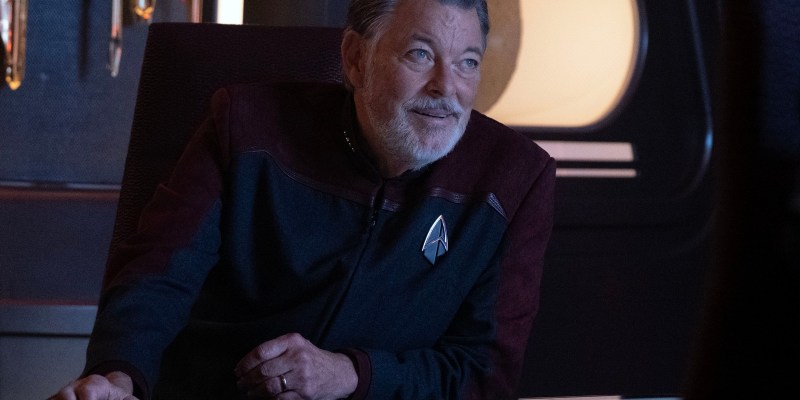This review and discussion contains spoilers for Star Trek: Picard season 3, episode 4, “No Win Scenario.”
To its credit, “No Win Scenario” is a competent slice of nostalgia, which makes it a success by the standards of the third season of Star Trek: Picard.
Of course, “No Win Scenario” demonstrates many of the recurring issues with Picard, most notably its eagerness to sacrifice storytelling at the altar of fan service. “Seventeen Seconds” ended with a bold cliffhanger, in which Captain William T. Riker (Jonathan Frakes) accused his old mentor Admiral Jean-Luc Picard (Patrick Stewart) of effectively condemning the crew of the USS Titan to death. Both men have apologized by the end of the teaser to “No Win Scenario,” and the matter is dropped.
Similarly, Seven of Nine (Jeri Ryan) finds herself tasked with identifying a Changeling infiltrator on the Titan, in what is essentially a retread of “The Adversary,” the third season finale of Star Trek: Deep Space Nine. Seeking advice from Captain Liam Shaw (Todd Stashwick), Seven sets out to find the infiltrator’s “pot,” the container in which they regenerate as their gelatinous self. Conveniently enough, that pot looks exactly like the one Odo (Rene Auberjonois) used on Deep Space Nine.
There are all manner of logical questions arising from this plot thread. Why would the infiltrator need a pot? If they needed to operate on the Titan without arousing suspicion, wouldn’t they regenerate in a less conspicuous space? They could regenerate in a drawer or a case, a seemingly innocuous nook that every Starfleet officer would carry in their quarters. More than that, why would the infiltrator use a container identical to Odo’s, given Odo used something he found on Bajor?
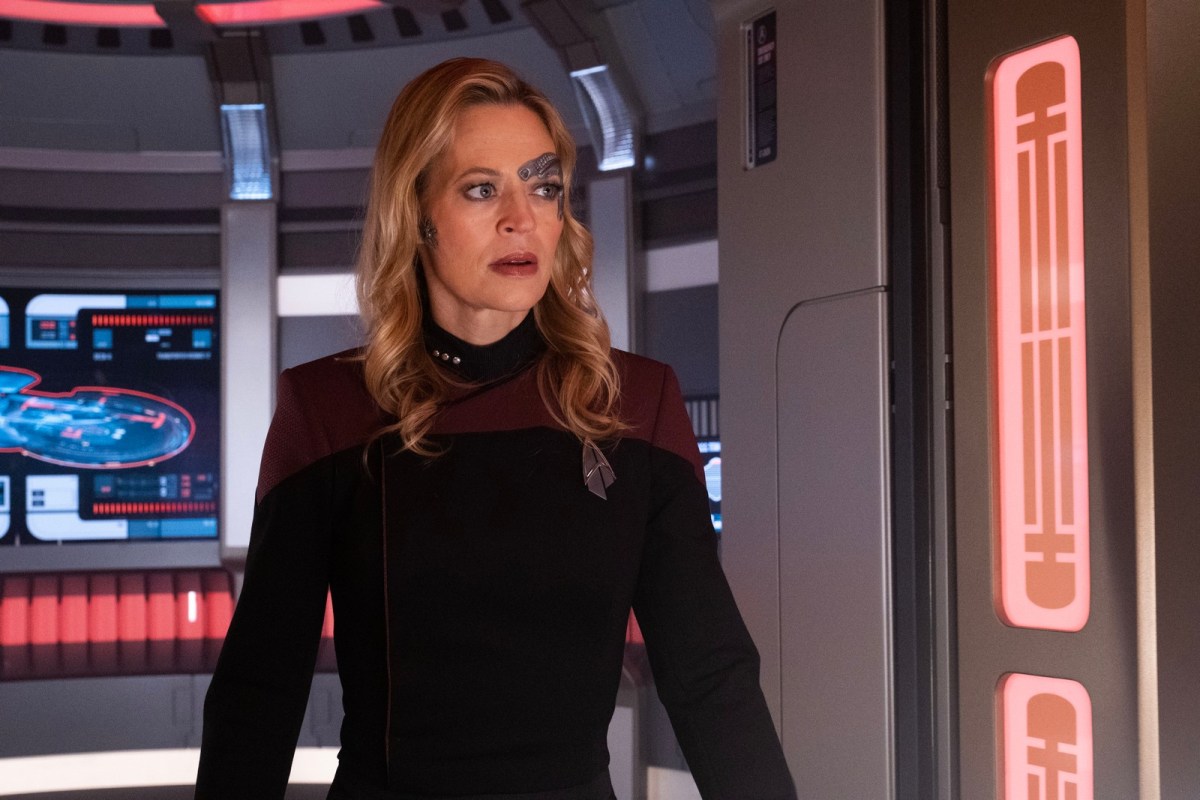
This might sound like nitpicking, an example of that exhausting trend of picking at “plot holes” within the larger narrative. However, it’s not the questions that are the point. After all, the answer is obvious: nostalgia. The infiltrator uses a “pot” that is functionally identical to the one employed by Odo on Deep Space Nine because the audience will recognize the pot as one that is functionally identical to the one employed by Odo on Deep Space Nine. Nostalgia as an end unto itself.
Despite these sorts of issues, “No Win Scenario” is the best episode of Picard’s third season to date. This isn’t an entirely backhanded compliment. “No Win Scenario” is an episode that is much tighter in terms of plotting and scripting than “The Next Generation,” “Disengage,” or “Seventeen Seconds.” It is better at the simple nuts and bolts of storytelling, which has historically been a major problem with the writing on Picard.
On a basic level, “No Win Scenario” manages a number of tidy setups and payoffs. Shaw describes himself as “a grease monkey” just a few scenes before Picard realizes that he needs “a grease monkey.” Seven recognizes the infiltrator posing as Sidney La Forge (Ashlei Sharpe Chestnut) because she doesn’t call her “Commander Seven,” paying off both Shaw’s guide to spotting Changelings earlier in the episode and La Forge’s use of “Commander Seven” in “Seventeen Seconds.”
This might sound like damning “No Win Scenario” with faint praise, and it kinda is. After all, none of this is exceptional. It is just basic competence in structuring a narrative. That said, there are a handful of truly exceptional moments in “No Win Scenario,” demonstrating an emotional heart sorely missing from the season around it. Shaw’s vivid memories of his experience of Wolf 359, while obviously indebted to those of Benjamin Sisko (Avery Brooks) in “Emissary,” are genuinely affecting.
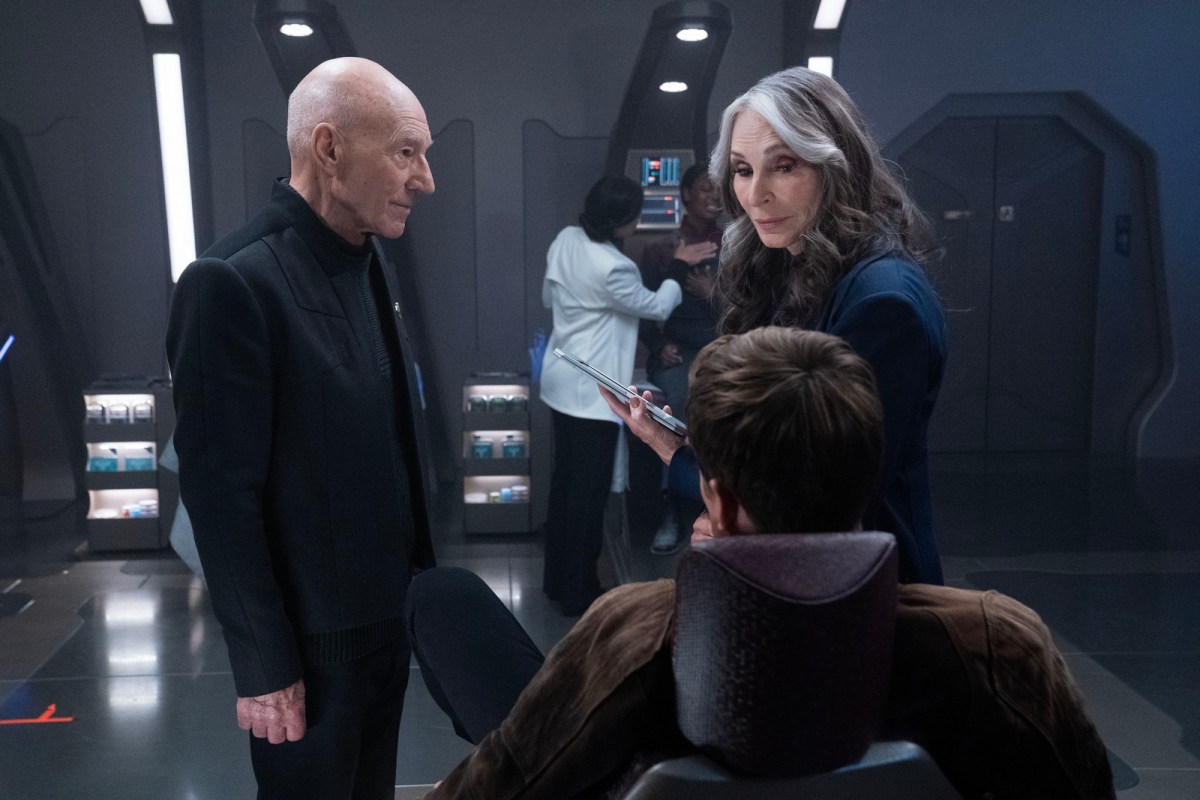
Stashwick is legitimately great monologuing about how “it felt like space itself was burning.” It’s a sequence that adds a lot of shading to his introduction in “The Next Generation,” and it allows Shaw to feel like an actual human being rather than a plot obstacle with dialogue. It might be too much to describe Shaw as a complex or multifaceted character, but “No Win Scenario” immediately makes him the most interesting character on Star Trek: Picard at this moment in time.
In other areas, “No Win Scenario” does the best that it can with the hand that it has been dealt. The flashback framing device of Picard regaling students with tales of his encounters with the Hirogen or the plot of “Darmok” does a decent job of suggesting how the character’s ego and pride may not make him particularly easy to love, as he smugly and unthinkingly deflects Jack Crusher’s (Ed Speleers) question about wanting “a real family,” replying, “Starfleet has been the only family I ever needed.”
Similarly, while the rift between William Riker and his wife Deanna Troi (Marina Sirtis) still feels like something that needed to be depicted on screen rather than explained via rushed exposition, “No Win Scenario” does a good job of having Riker explain the cause of the separation in the episode’s teaser and then pay off that explanation in the episode’s closing scenes. Again, this is just basic storytelling, but it is much cleaner than Picard usually allows itself to be.
Along those lines, there is some neat theming at play here. Ostensibly, Picard is a show about parents and children, whether those relationships are effective or not. That carries over to the third season, in which Riker is still dealing with the loss of his son and Picard is confronted with the existence of his. So it makes sense that the anomaly at the center of the nebula is an extension of that theme, with Jack rather memorably describing the aliens as “space babies.” It’s not subtle, but it is efficient.
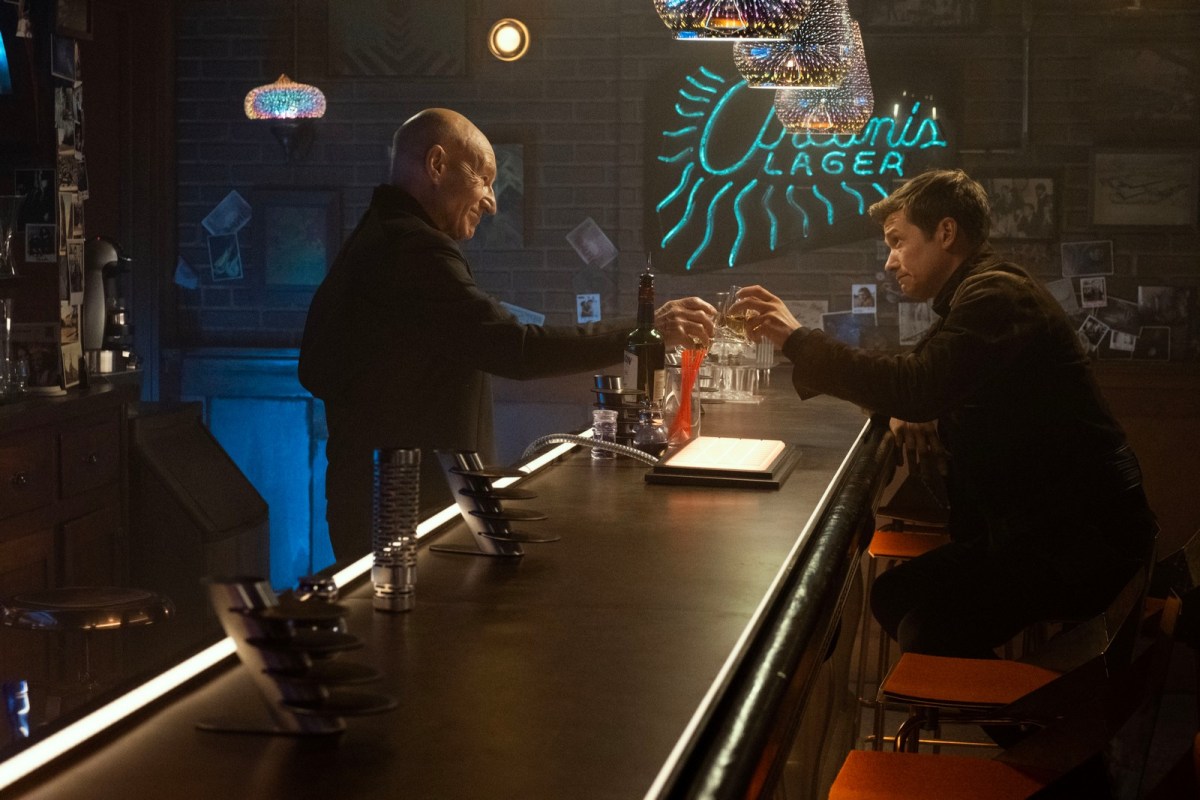
“No Win Scenario” is an episode that, for better and worse, understands the assignment. It leans hard into nostalgia, recognizing that nostalgia is basically the entire raison d’être of this whole season. So, “No Win Scenario” commits to “nostalgia-ing” better than the episodes around it, and it succeeds in those terms. There is admittedly something quite charming in how committed “No Win Scenario” is to reminding its audience how much they enjoyed the Rick Berman era of Star Trek.
Indeed, one of the episode’s smaller and more charming slices of nostalgia concerns the ubiquity of the holodeck as a plot device. As the Titan faces its doom, Picard sets up a safe space in the holodeck for the beleaguered crew. Jack understandably asks whether the power could be put to better use, recalling the old debates about the frequent use of the holodeck on Star Trek: Voyager, a show that was supposed to be about a ship trapped on the opposite side of the galaxy with limited resources.
“It relies on a small independent power cell for this very reason,” Picard helpfully explains. “So in times of distress, it can be a kind of sanctuary.” It’s debatable whether that makes any real sense. Certainly, one imagines that Riker would be very happy to transfer holodeck power to the engines at the episode’s climax. However, it’s a handwave explanation that is charmingly consistent with the handwave explanation that Voyager offered in “Parallax,” its first standalone episode.
“No Win Scenario” is structurally closer to an episode of The Next Generation or Voyager than any of the previous three episodes, an ideal to which the third season of Picard is aspiring. It runs through a checklist of familiar elements. There is a briefing room scene, in which the crew pitch a last-ditch plan to Riker. Shaw distills the technobabble pseudo-science to a relatable metaphor of “hotwiring.” Riker even delivers a stirring speech to rally the crew before the Titan commits to this course of action.
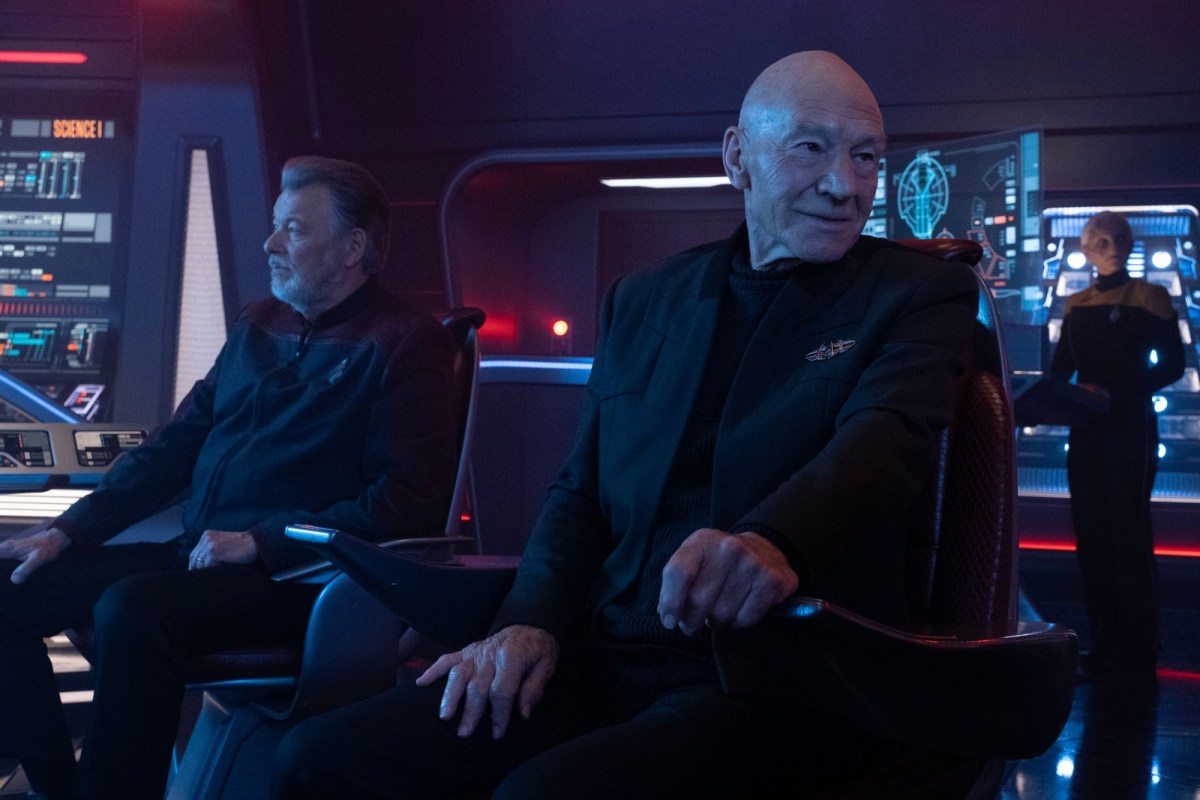
“No Win Scenario” makes a point to directly evoke a specific episode of The Next Generation, to the point that the episode all but explicitly names it. When Crusher (Gates McFadden) points out that the crew has “encountered species before — life forms — that thrive in the vacuum of space,” Picard references the events of “Encounter at Farpoint.” That was the first episode of The Next Generation, and the jellyfish-like design of the aliens evokes the ending of that two-part premiere.
Again, it is neither subtle nor elegant. The third season of Star Trek: Picard is being framed as another finale for The Next Generation, so a reference to the very first episode makes sense — and “No Win Scenario” works hard to ensure that no audience member could possibly miss the allusion. As with a lot of the episode around it, there is an endearing competence in this choice. Credit is due to writers Terry Matalas and Sean Tretta.
Still, even as the third season of Picard finally manages to hit its mark, there is something frustrating that the show has set its sights so low. “No Win Scenario” is effectively a stock “anomaly of the week” episode, the bread and butter of The Next Generation, Voyager, and Enterprise. At its peak, the franchise was reliably churning out a variety of forgettable episodes like this each and every season. It’s a photocopy of a template the franchise has already replicated countless times.
“No Win Scenario” is basically a photocopy of episodes like “Parallax,” “The Cloud,” “Elogium,” “Twisted,” “Demon,” “One,” “Bliss,” “The Fight,” “The Haunting of Deck Twelve,” “The Void,” “Vox Sola,” “Singularity,” and “The Catwalk.” These are episodes that exist on a spectrum between “terrible” and “fine,” but which all but the most ardent Star Trek fan would struggle to remember from the title alone.
Then again, Strange New Worlds suggested this is the aspiration for modern Star Trek. “No Win Scenario” aims to be perfectly mediocre and forgettable Star Trek, riding a wave of nostalgia. Whatever else one might say about it, it succeeds on those terms.
